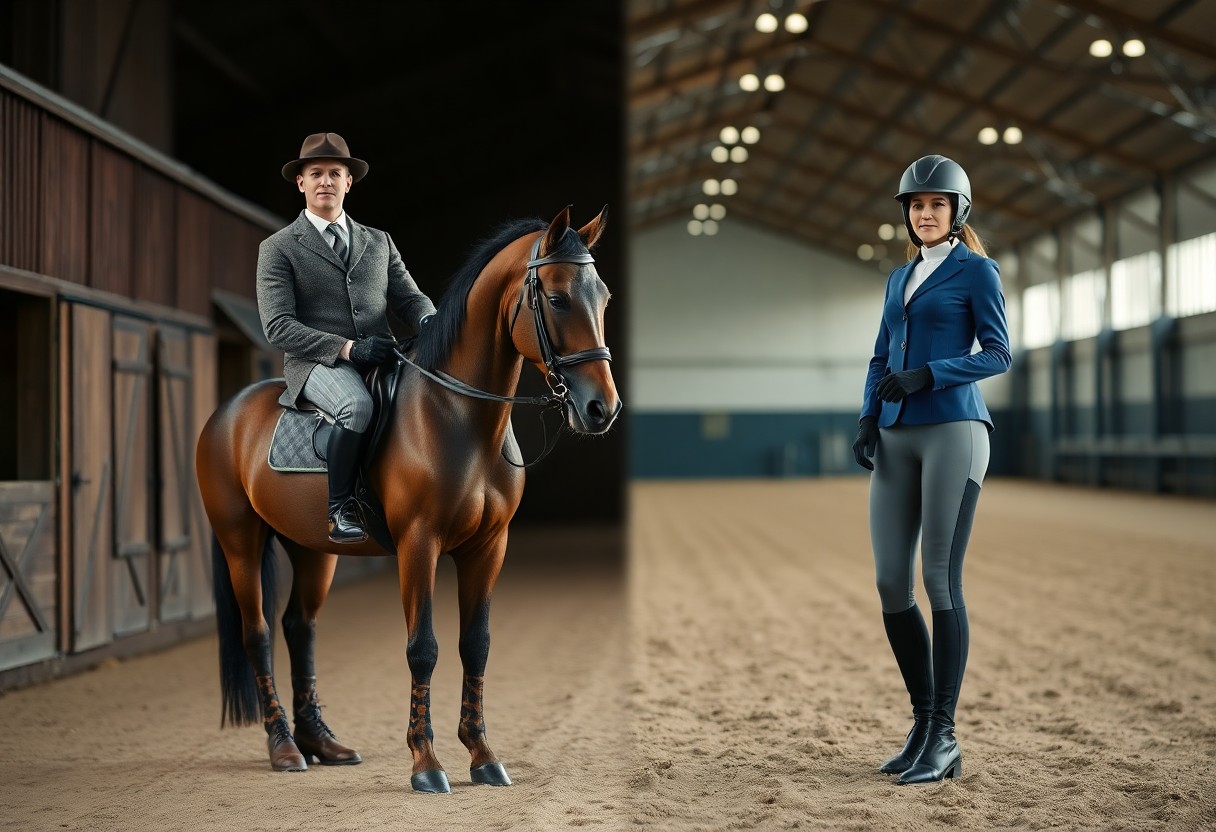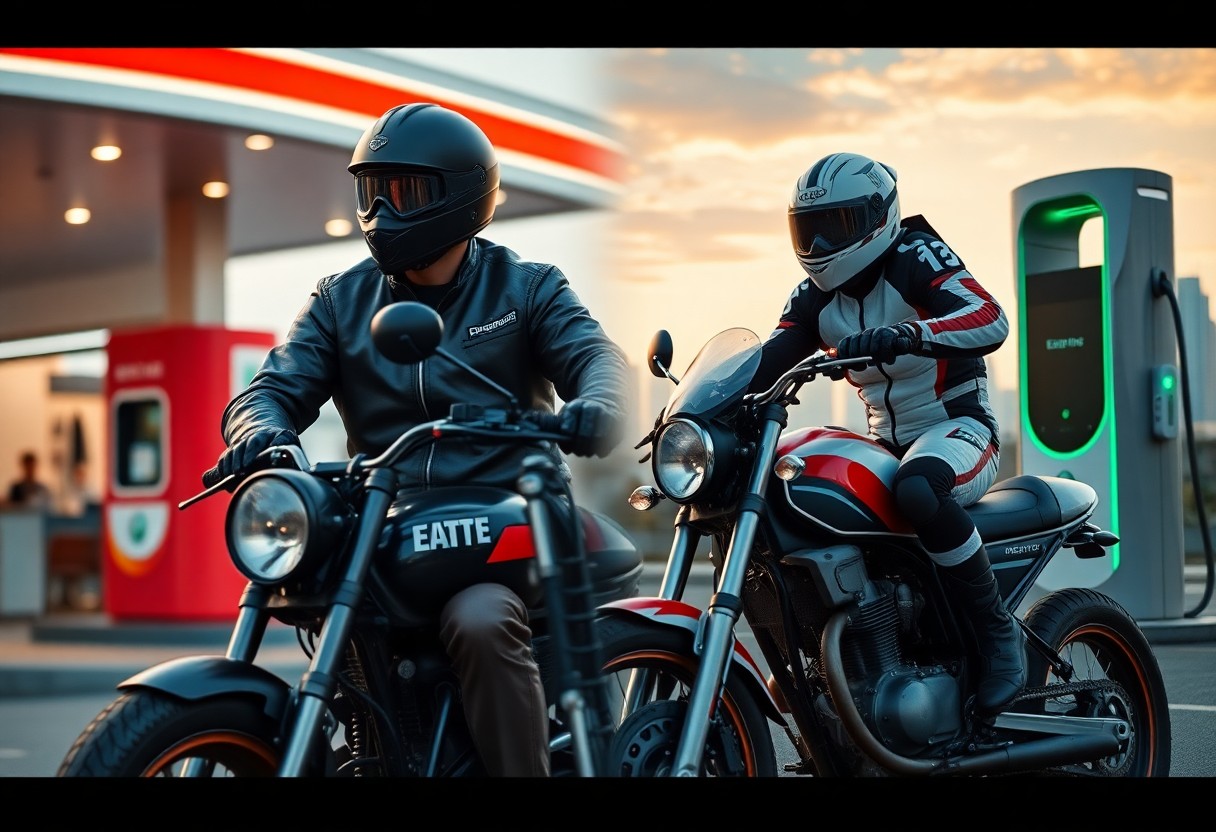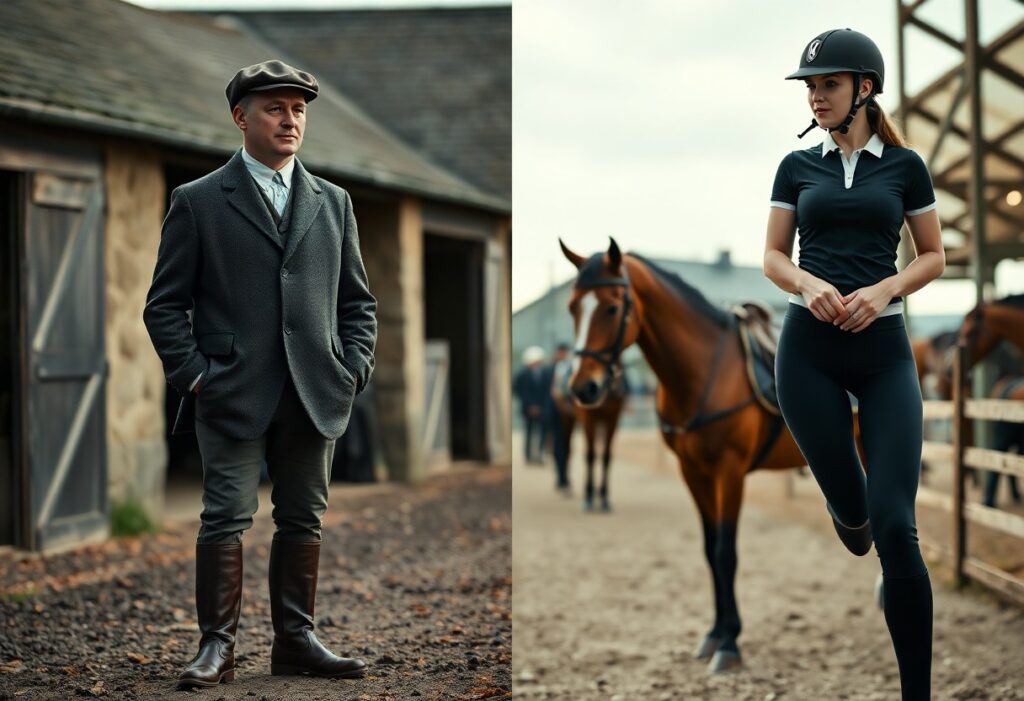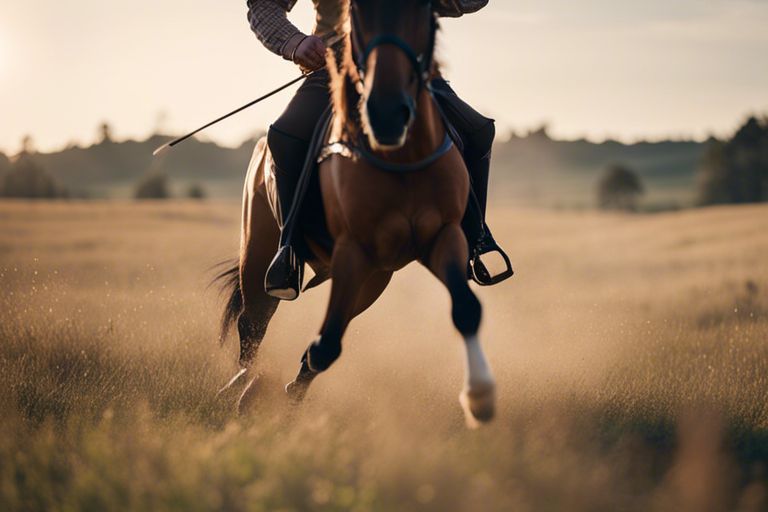Over the decades, your riding attire has undergone significant transformations, reflecting both cultural shifts and advancements in technology. As you explore the differences between traditional and modern styles, you’ll discover how each era has influenced comfort, safety, and performance on horseback. Understanding this evolution not only enhances your appreciation for riding but also guides you in making informed choices for your own riding wardrobe.
A Fashionable Foundation: The Origins of Riding Attire
You might be surprised to learn that riding attire has roots dating back centuries, reflecting both functionality and social status. Designed initially for practical use, riders needed clothing that would not inhibit movement and would offer protection while on horseback. Over time, garments evolved to symbolize the sophistication of the equestrian lifestyle, making a mark not only on the field but also in fashion.
Historical Context of Equestrian Clothing
The historical backdrop of equestrian clothing stems from the necessity of riding for transportation, hunting, and warfare. In medieval Europe, horseback riding was imperative for nobility and knights, leading to clothing specifically designed for comfort and durability. As riding transitioned from a necessity to a sport and leisure activity, attire began to reflect both style and status, indicating the wearer’s interests and wealth.
The Materials and Designs That Defined Early Riding Gear
Initial riding gear was characterized by its use of sturdy materials like wool and leather, chosen for their durability and protection. Early designs included tailored jackets, breeches, and riding boots, which allowed optimal movement and were often adorned with decorative elements to signify rank. The craftsmanship involved in creating these garments set a standard for the quality expected in riding attire.
For instance, wool was favored for its natural insulating properties, allowing comfort in a variety of climates. Leather boots provided ankle support and grip while riding, proving indispensable for control and safety. Breeches were tailored for a close fit to minimize bulk and improve mobility, often crafted with intricate stitching or embroidery that showcased individual taste and societal standing. These elements not only fulfilled practical needs but also established a visual identity for riders, laying the groundwork for contemporary riding fashion.
The Roaring Twenties: A Turning Point in Riding Styles
The 1920s marked a significant transformation in equestrian fashion, where practicality and modernity began to reshape traditional riding attire. Women increasingly embraced more liberated styles, favoring functional clothing ideal for both riding and social events. This era saw a shift toward less restrictive garments, allowing greater freedom of movement, which reflected broader societal changes towards women’s rights and shifting cultural norms.
The Influence of Social Changes on Equestrian Fashion
Social changes during the 1920s, including the rise of the flapper movement, profoundly influenced equestrian fashion. You witnessed the blending of femininity with a newfound sense of independence, leading to the adoption of more practical and stylish riding gear. The desire for mobility and self-expression was paramount, prompting designs that not only enhanced performance but also catered to a modern aesthetic.
Iconic Outfits and Trends from the Era
Iconic outfits from the 1920s included the tailored riding jacket, knee-length breeches, and stylish, wide-brimmed hats. You might have noticed women donning a chic combination of comfort and elegance, often pairing fitted jackets with loose blouses. Fabrics like twill and tweed became popular choices, ensuring both durability and style on the ride.
Riding outfits during this time epitomized the spirit of the Jazz Age, with the tailored riding jacket often adorned with decorative buttons and contrasting lapels. Breeches were cut to fit snugly at the waist, emphasizing a streamlined silhouette. Accessories such as leather gloves and silk scarves completed the look, perfectly balancing form and function. The adoption of fabrics like gabardine and cotton provided comfort, allowing you to engage in a wide range of equestrian activities while exuding an air of sophistication. These trends not only underscored your style but also showcased a significant shift towards functional, fashionable riding attire that resonated with the evolving culture of the decade.
Mid-Century Modernization: Riding Attire in the Post-War Era
The post-war era of the 1950s and 1960s witnessed a drastic shift in riding attire, embracing both style and functionality. You’d find tailored jackets with sharper cuts, high collars, and fitted trousers that made riding not only a sport but a fashion statement. The emergence of classic colors and patterns brought an elegant touch to the equestrian wardrobe, giving you the chance to express personality while adhering to the sport’s traditional roots.
Shifts in Fabric Technology and Functionality
Advancements in fabric technology during this time significantly enhanced your riding experience. You benefited from materials like cotton blends and synthetic fibers designed to provide better stretch, breathability, and water resistance. This innovation meant greater comfort in the saddle and increased durability of your riding attire, allowing for more frequent use without sacrificing style.
The Emergence of Women in Competitive Riding
As women increasingly participated in competitive riding during this period, riding attire began to evolve to meet their needs. You witnessed changes in both design and fit, with brands catering specifically to the female form. This shift not only symbolized progress in women’s roles within equestrian sports but also allowed you to showcase your own individual style in competitions.
The increase of female equestrians at competitions in the mid-20th century called for innovative riding attire that was functional yet flattering. You saw tailored jackets cinched at the waist, alongside well-fitted breeches that allowed for freedom of movement. Events such as the Olympics began to include women’s events, further propelling the demand for stylish yet practical clothing suited for performance. This period ultimately laid the foundation for today’s diverse and contemporary riding attire you see in the arena.

The Resurgence of Tradition: The 1980s and 1990s Equestrian Revival
The 1980s and 1990s marked a vibrant revival of traditional equestrian attire, as riders sought to reconnect with classic styles amid a rapidly changing fashion landscape. This period saw the return of tailored jackets, high-necked shirts, and polished leather accessories, reflecting a broader cultural nostalgia for heritage and authenticity. Equestrian events, driven by media exposure and participation, became platforms to showcase this resurgence, blending both functionality and style in a contemporary yet timeless manner.
Nostalgia for Classic Styles—What Drove It?
A yearning for the elegance and simplicity of past equestrian fashion became pervasive during this era, sparked by a renewed interest in the equestrian lifestyle. Iconic films and magazines started to portray riders in classic attire, fueling admiration for skilled horsemanship and tradition. This nostalgic sentiment resonated with both seasoned riders and newcomers, who sought to embody the sophistication of equestrian history while enjoying the modern riding experience.
Notable Brands and Their Impact on Riding Culture
Brands like Hermès, Ariat, and Pikeur played pivotal roles in shaping the riding culture of the 1980s and 1990s. Hermès not only reinforced its legacy in luxury equestrian gear but also popularized the notion of riding as a fashionable pursuit. Ariat, known for its innovative designs, introduced performance-focused attire that appealed to a new generation of riders. Simultaneously, Pikeur combined tradition with modernity, offering fits and fabrics that became staples in both competitive and casual circles.

Contemporary Innovations: Riding Gear in the 21st Century
In the 21st century, riding attire has seen a dramatic shift towards *innovation and performance*, blending traditional aesthetics with modern technology. Enhanced by advanced materials, your gear now prioritizes comfort, safety, and functionality without compromising style. From smart textile applications that monitor body temperature to breathable, water-resistant fabrics, contemporary riding apparel adapts seamlessly to your needs, whether you’re competing or enjoying a leisurely ride.
High-Tech Fabrics and Customization Options
Your riding gear has embraced *high-tech fabrics* that offer features like moisture-wicking, UV protection, and stretch for freedom of movement. Customization options allow you to personalize fit and design, ensuring your attire reflects your individual style while enhancing your performance in the saddle.
The Influence of Sustainability on Riding Apparel Choices
The focus on sustainability is reshaping your choices in riding apparel, as manufacturers increasingly prioritize eco-friendly materials and ethical production practices. Options made from recycled and organic materials not only reduce environmental impact but also promote a conscious lifestyle among riders.
Further awareness of sustainability in the equestrian community has led to a significant rise in brands offering *sustainable alternatives*. For instance, companies like *Pikeur* and *Dada Sport* have introduced collections made from recycled plastics, while other brands actively support fair trade practices. By opting for these eco-conscious products, you contribute to a greener future while enjoying high-quality, functional riding attire that aligns with your values.
Conclusion
With these considerations, you can appreciate how riding attire has evolved from traditional styles to modern designs, reflecting changes in fashion, technology, and rider comfort. Understanding this evolution can enhance your riding experience, allowing you to select gear that not only meets contemporary standards but also honors the rich heritage of the sport. By bridging the gap between past and present, you can make informed choices that align with your personal style and riding needs.
FAQ
Q: How has riding attire changed from traditional styles to modern designs?
A: Traditional riding attire typically included items like jodhpurs, tweed jackets, and tall boots, emphasizing formality and a classic aesthetic. Modern riding attire has evolved to prioritize comfort and functionality, incorporating breathable fabrics, fitted designs, and safety features such as body protectors and enhanced footwear. This evolution reflects the changing preferences of riders and advancements in material technology.
Q: What are the key features of modern riding attire that differ from traditional clothing?
A: Modern riding attire often includes moisture-wicking fabrics, stretch materials for better movement, and protective gear that was less common in traditional attire. Innovations like silicone grip breeches and tailored jackets enhance performance. Safety elements, such as helmets with improved ventilation and impact resistance, are now standard, whereas traditional attire focused more on style.
Q: How do cultural influences affect riding attire trends throughout the decades?
A: Over the decades, regional styles and cultural influences have shaped riding attire. In the past, European styles dominated, emphasizing sophistication and elegance, while modern attire reflects a blend of global trends, with influences from casual sportswear and street fashion. These shifts indicate broader societal changes, including increased participation in equestrian activities across different demographics and lifestyles.











